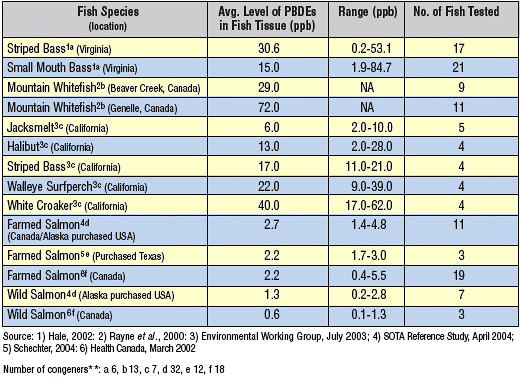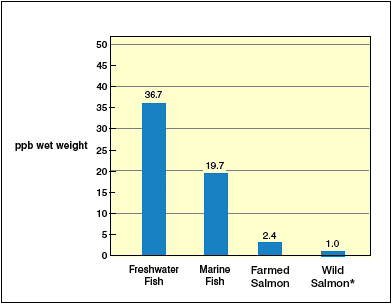Flame retardants (PBDEs) are being found in the environment in ever increasing amounts. Unlike some other persistent organic contaminants, their production has not been eliminated, so while levels of others such as PCBs continue to decline, PBDEs continue to rise. As this happens we see a rise in PBDE levels in humans.
While there are some similarities to other contaminants like PCBs, there are also important differences. Thus what we know about others, such as PCBs, for example, cannot be extrapolated to PBDEs which compounds the problem because so little is known about them. For instance, while we know that foods are one route of PBDE uptake, unlike in PCBs, there are likely other ways PBDEs enter the body.
Inhalation from PBDE contaminated dust is one possibility. Foods tested to date show very low levels--on the order of several parts per billion. However, dust in rooms that have a number of PBDE "emitters" has been shown to have levels at parts per million, an order of magnitude greater. Dermal (skin) intake is another possibility.
Levels in most foods are not well defined. In salmon, however we have three recent studies. They show PBDE levels in both farmed and wild salmon to be very low and currently well below the level where they present any health risk. Levels in farmed salmon will be constantly monitored and this tracking will also help identify the source of these environmental contaminants so salmon producers can work to eliminate them.
Several studies to determine PBDE levels in other foods are in the planning stages. Results can be expected in several months, with enough data to make broad conclusions comparable to what we have in farmed salmon in a year or so.
PBDEs in Fish
Several studies have examined levels of PBDEs in marine, freshwater and farmed fish in North America. Representative results are presented in the table below. In general the following is found:
North American freshwater fish generally have much higher PBDE levels than do their marine counterparts. These are noted in the study results from Virginia and the Columbia River in Canada.
Several species of marine fish in North America, including those in California (San Francisco Bay), have some of the highest PBDE levels found in marine fish anywhere in the world and several times higher than in any farmed fish in any study to date.
The fish with the greatest number of samples is farmed salmon. Three separate studies show levels in farmed salmon are, on average, less than 2.5 ppb, the range typically being 1 to 4 ppb. Wild salmon, on average, contain 1 ppb with the range being 0.2 to 3 ppb. For wild salmon the number of samples is inadequate to fully define the range or the true average.*

(from Table 1)

*The table shows considerable variation in PBDE levels in both farmed and wild salmon. In the farmed salmon these figures represent samples from a majority of salmon farms in Canada (estimated to account for 90% of production). For wild salmon, however, the figures represent only a small fraction of the salmon runs in Canada and Alaska. Each run has different migratory and feeding patterns which influence the accumulation of POPs, including PBDEs, so we would expect the variability to be much greater than in the more controlled and uniform farmed salmon operations. More wild salmon samples are needed to fully define this range of variability. Until then, caution should be used in comparing the upper end of the range of wild and farmed salmon or the average values.
**As noted in the table, different studies measure levels of differing numbers of the 209 theoretically possible PBDE congeners. While there is general agreement that not all 209 have to be measured, there is still no standard number of congeners used in various studies. However, the difference in PBDE levels between a study that analyzes for 32 congeners, as in the SOTA study, and the 12 most common ones, as in the Schechter study, is on the order of about 15 percent. Thus it does not substantially affect the estimate of total the PBDE content.
PBDE Facts
Overall, and in comparison with other high profile contaminants, there is still very little known regarding PBDEs. There remain numerous critical questions about how they enter the environment; how they move into and behave within biota; and how they are transported through food chains. Therefore, conclusions regarding how to mitigate exposure to these substances are uncertain and have to be based on theoretical considerations related to their physical/ chemical properties and uses.
While there are always concerns about contaminants in our environment, and especially in the food chain, at this time PBDE levels are relatively low compared to other contaminants. Thus, the focus must be on preventing their release into the environment so that water, air and the food chain are not further contaminated to a point where levels pose a public health problem.
PBDEs are brominated organic compounds that have recently gained significant attention, due to their increasing levels, persistence, and potential for accumulation and toxicity.
PBDEs are used as flame retardants in thousands of products where they typically comprise 5 to 30 percent of product weight. In most cases, PBDEs are simply mixed into the product, so they do not form a chemical bond and, thus, may migrate out. Hence they have been reported at part per million concentrations in house dust and sewage sludge.
It has been reported that North Americans have 20 times greater levels of PBDEs in their tissues than Europeans. This is likely related to greater use of flame retardants in the U.S.
PBDE concentrations in human tissues in the United States appear to be increasing, with estimated doubling times of about 4-6 years.
There are currently three commercial PBDE formulations in use, namely: Octa-PBDE, Penta-PBDE, and Deca-PBDE. The Octa- and Penta- formulations are being banned in Europe this year. Likewise, North American companies are voluntarily phasing out their production of these by the end of 2004.
Deca-formulations have been thought to be less of a problem, as they are found at much lower levels in biological systems. This is thought to be the case due to their low bioaccumulation and transport potential because of their large molecular size. However, difficulties in analysis may result in understating their presence. The possibility of limited degradation to different PBDE congeners once released is under study. This is but one of the riddles of PBDE analysis and behavior to be solved.
While dietary exposure is presumed to be the main route of uptake, other routes, may be significant. Inhalation of PBDEs from dust which contains PBDEs accumulated from air vapor and dermal exposure from furniture have been recently identified as potentially significant sources of PBDEs. While PBDE levels in food are measured in parts per billion, dust contaminants in indoor air can measure in parts per million, or a thousand times greater.
While the increasing levels in the environment and in foods is cause for concern, at the current concentrations detected with limited studies, PBDE levels in food are not believed to be a food safety issue in commercially produced foods.
While research to date suggests that the possible human health risk is limited, concern remains about the effects of PBDEs on humans, mainly due to inadequate research on them. Relatively little is known about the toxicity of PBDEs. Currently, the available studies indicate that developmental neurotoxicity and effects to the thyroid are the critical effects. PBDEs have been shown to have dioxin-like toxicity, but are much less potent when compared to PCBs or dioxins/furans. There is a paucity of carcinogenicity data; however, PBDEs do not appear to be genotoxic, suggesting that these compounds are not DNA-reactive carcinogens. The toxicological potencies of the different individual constituents of the mixtures, known as congeners, have not been determined.
More information is needed on the concentration of PBDEs in various foods in the United States and Canada, as well as the relative contribution of PBDEs in different food groups to total dietary intake.
As PBDEs tend to accumulate in fats, fish and other foods containing relatively high levels of fats, these appear to contain more PBDEs. However, because there is so little information now available, it is impossible to draw any broad conclusions about specific foods at this time.
While both PCBs and PBDEs are lipophilic, it is not possible to say with certainty that there is a close correlation of levels of PCBs and PBDEs in specific foods. These two chemical groups were used in different products and major consumption of PCBs ended nearly three decades ago. Hence, some major differences in environmental distribution and exposure are likely.
Source: Salmon Of The Americas - May 2004.



